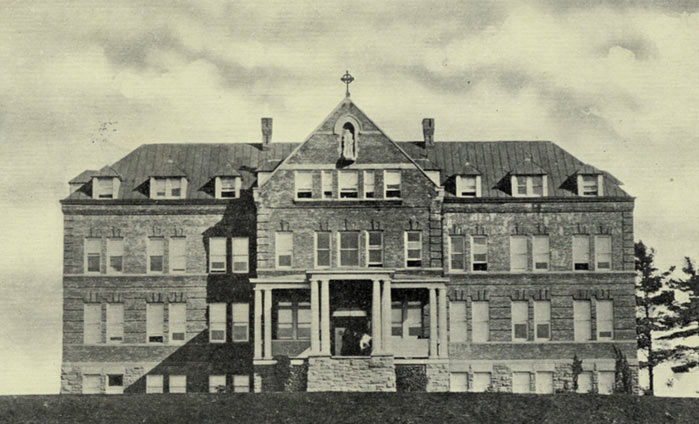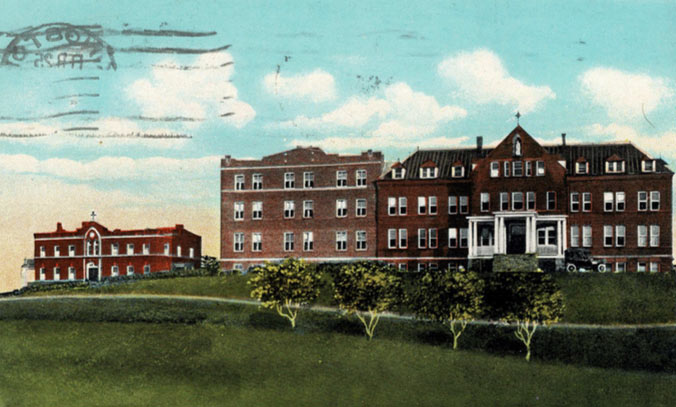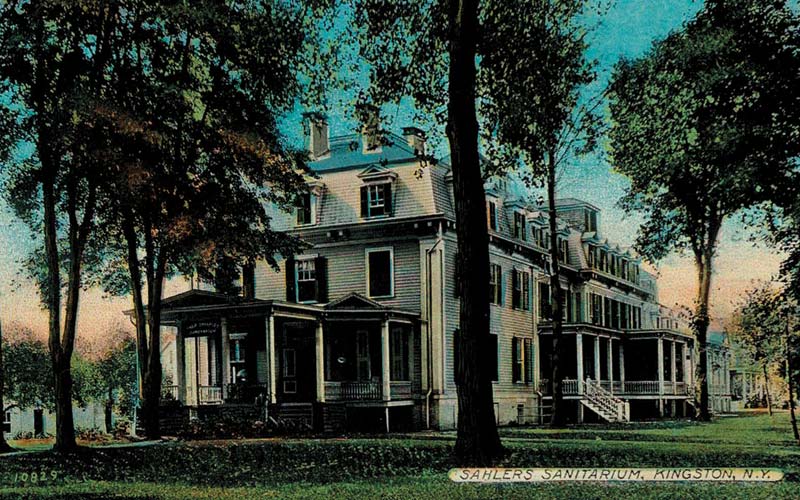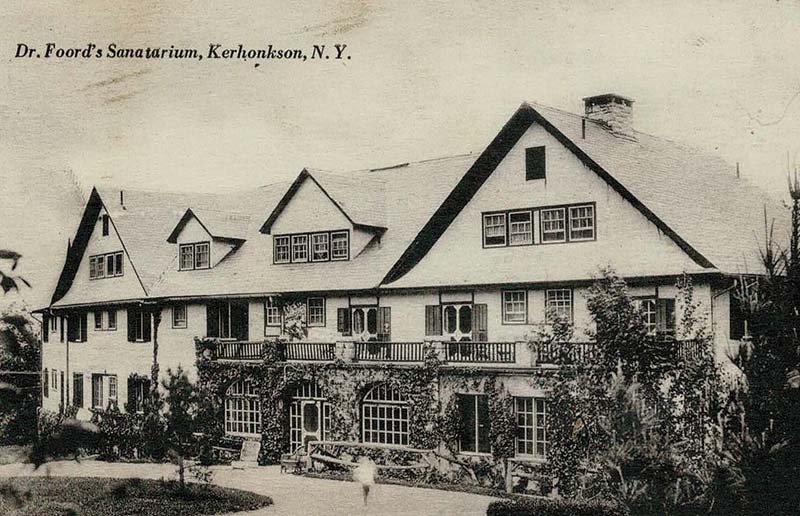
The Benedictine Sanitarium, Kingston, NY. Image from a postcard postmarked 1907.
A Little Kingston TLC History
Spring 2020
Care of the sick in Kingston, as in all communities and throughout history, began with home care as alternatives were few, expensive, and far away, not to mention, often not effective or downright deadly. It is only in the last half-century that we take good hospital care as a given.
The earliest reference I found for a hospital in Kingston is in the book The History of Kingston New York from its Early Settlement to the Year 1820 by Marius Schoonmaker. The author described the various orders given by the British commanding the building of lodging for officers and troops, and to make repairs, provide furniture, etc. as requested by the officers. Most of this was to be accomplished in 1757, well before the British burned up their welcome in Kingston.
The most important part of the British orders reads as follows: “They were also subsequently directed to provide the officers and soldiers with firewood. On the 14th of December, 1757, the trustees appointed Adam Swart and Cornelius Low a committee to procure and provide a house for a hospital, and to furnish it with necessary beds and bedding.”
After the British decamped and then returned and attacked Kingston, the city was rebuilt and it prospered. But its pubic health care did not really come into its own until 1890 when, according to a note in the Columbian Republican newspaper of June 5, 1890, “A movement is on foot in Kingston for the establishment of a city hospital.”
The April 28, 1893 Catskill Recorder reported, “The cornerstone of the Kingston City Hospital was laid on Saturday last with the appropriate ceremonies.”

postcard, 1886, Kingston City Hospital, Kingston, N.Y.
Raising funds for the hospital included a kirmess (a fair or event held for charitable purposes) run by Miss Margaret Eager, an apparent star of such fund-raisers. This affair was well-publicized in almost every surrounding newspaper for several days preceding the event. Special West Shore Railroad excursion tickets to Kingston and return were just $1 which included admission to one of the several performances. In this kirmess, dancers and singers in costume from twelve nations performed.
Subsequent newspapers of the era often included where victims of accidents, diseases, and crimes were taken, and so Kingston City Hospital’s name is prominent from 1895 to today.
In 1901, four Benedictine nuns in Kingston began caring for their Catholic brethren at Our Lady of Victory Sanitarium. Their effort eventually grew to more than 100 beds and is pictured at top and below. Eventually, it became Benedictine Hospital under the spiritual guidance of the sisters.

The Benedictine Hospital and Nurses Home, Kingston, NY. Image from a postcard postmarked 1939.
In 1977, the Benedictine Health Foundation was incorporated, and by 2012 mega changes in the Hudson Valley health care industry were taking place. HealthAlliance of the Hudson Valley consolidated services at the two Kingston hospitals to avoid the duplication of services that had developed over the preceding century. Benedictine ceased being the “Catholic” hospital; today, it is called Mary’s Avenue Campus with Kingston Hospital renamed Broadway Campus.

Sahler’s Sanitarium, Kingston, NY. Postcard, no postmark, but circa 1908
The City of Kingston had other important institutions that cared for specific ailments or populations. Dr. Sahler’s Sanitarium, pictured above, was often mentioned in newsprint. One article in the August 18, 1911 Poughkeepsie Eagle, discussed the death of a well-known school principal and hinted at suicide while at the sanitarium. Dr. Sahler told the reporter he would rather any information on the death “…come from the family.”
In the August 31, 1915 Eagle, the Sahler Sanitarium is mentioned as a meeting place for the County Prohibitionists to take place on September 1st. The notice ends with the sentence, “A number from this place (Poughkeepsie) will doubtless attend.”
Another Ulster County sanitarium belonged to Dr. Andrew G. Foord of Kerhonkson. The good doctor was apparently as concerned about the health of the area forests as of his patients. The May 10, 1927 Glens Falls Times mentioned he had completed his first re-foresting plantation in 1914 and was at it again. The article titled “N.Y. Planting 20 Million Trees in Reforesting,” said this time Foord planned on planting 10,000 pine, spruce, and balsam seedlings. The New York Conservation Commission said Foord’s initial forest was very satisfactory especially with the Norway spruce and red pine varieties.

Dr. AG Foord’s Sanitarium, Kerhonkson, N.Y. Postcard image circa 1920.
Other stories about the sanitarium are far less cheerful. One from the May 26, 1920 Port Jervis Daily Union, told of a 13-year-old girl who jumped from a hotel’s second floor escaping a fire. In addition to the injuries from jumping, the child was burned. Her mother, after alerting other guests of the fire, did not herself escape. The paper reported the child “…lies in the Dr. A.G. Foord Sanitarium, Kerhonkson. Her condition is considered critical.” We were unable to determine her fate.

Dr. Foord’s Residence, Kerhonkson, N.Y. Postcard image circa 1920.
Judging from the postcard images of Dr. Foord’s Sanitarium and home, shown above, Dr. Foord was a very good businessman. A December 12, 1916 Orange County Times Press headline stated, “Dr. Foord Contemplates Starting a Mill.” Here we learned why he was interested in planting trees: “Dr. A.G. Foord of the Foord Sanitarium, near Kerhonkson, is cutting a large amount of timber on his property at that place. It is understood that he contemplates putting in a heading mill and may start an excelsier factory.” Excelsier is a wood shaving product, sometimes called wood wool that was used as protective packaging for delicate items during shipment.
Side note: I have included so many varied newspaper sources to indicate a few things about the era and our area. First, the number of newspapers was impressive, as is the detailed reporting on events and people not really related closely with the paper’s circulation area. In most instances, I did not quote all the newspapers that touched on the subject at hand. Much of what was printed in newspapers was of the gossip variety, “So and so visited x and y,” “John Doe is in the hospital.” This makes finding individuals’ personal connections from the late 1800s and throughout the 1900s almost on a par with today’s Facebook posts by one’s nosy neighbors.
